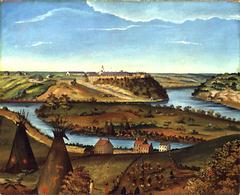Curriculum Materials: Art in America
|
|
Image 7 Edward K. Thomas Questions: |
Think Questions
1. Edward K. Thomas made at least four paintings of Fort Snelling while stationed there. Why do you think he did that? Why might someone want a painting like this?
2. Do you think Thomas was more interested in telling a story about Fort Snelling or showing exactly what he saw? Support your response.
3. The U.S. Army built Fort Snelling to ensure American control over this area. What does this painting tell you about Euro-American attitudes toward the wilderness in the mid-19th century? Does this attitude still exist today? What can people do today to prevent the destruction of the wilderness?
4. Why do you think Thomas included the Dakota Indians in the FOREGROUND of this painting? What details did he include to identify them as Indians? Many European Americans at this time believed that the Native Americans were less civilized than they themselves were. How does Thomas's representation contribute to this stereotype? What stereotypes of Native Americans still exist today? In what ways are these stereotypes damaging?
5. Compare and contrast Thomas's painting View of Fort Snelling to Henry Lewis's contemporary painting St. Anthony Falls. Where are these sites? What do these paintings have in common? What view of nature does each present? What does each say about the relationship of humans to nature in the mid-19th century? Which one appears more accurate? Why? What might account for their very different painting styles? When was each painting made? Fort Snelling was constructed between 1820 and 1824 using logs from a mill built by U.S. soldiers at St. Anthony Falls. Considering this information along with the dates of each painting, which one seems more accurate? Also discuss the ways both artists misrepresent the American Indians. How do their representations differ?
|
|
